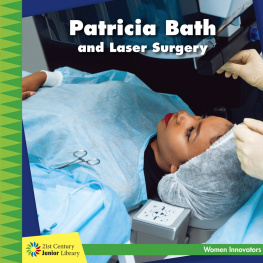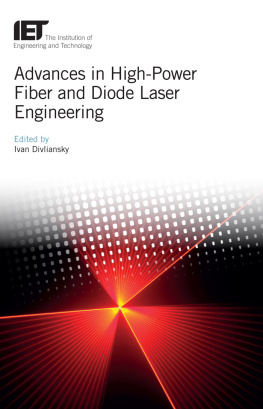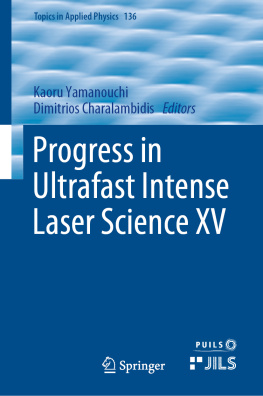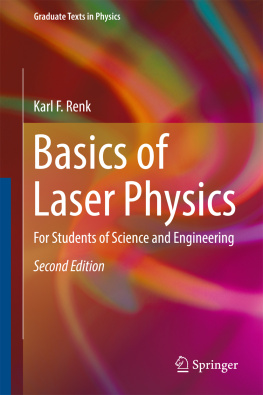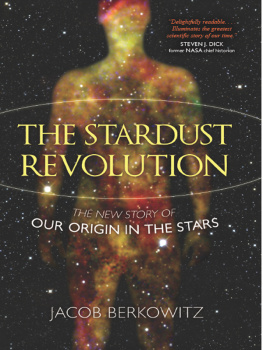HOW THE LASER HAPPENED
How The Laser Happened
ADVENTURES OF A SCIENTIST
Charles H. Townes


Oxford New York
Athens Auckland Bangkok Bogot Buenos Aires Cape Town
Chennai Dar es Salaam Delhi Florence Hong Kong Istanbul Karachi
Kolkata Kuala Lumpur Madrid Melbourne Mexico City Mumbai
Nairobi Paris So Paulo Singapore Taipei Tokyo Toronto Warsaw
and associated companies in
Berlin Ibadan
Copyright 1999 by Oxford University Press, Inc.
Published by Oxford University Press, Inc.
198 Madison Avenue, New York, New York 10016
www.oup.com
First issued as an Oxford University Press paperback, 2002
Oxford is a registered trademark of Oxford University Press
All rights reserved. No part of this publication may be reproduced,
stored in a retrieval system, or transmitted, in any form or by any means,
electronic, mechanical, photocopying, recording, or otherwise,
without the prior permission of Oxford University Press.
Library of Congress Cataloging-in-Publication Data
Townes, Charles H.
How the laser happened : adventures of a scientist / by Charles H. Townes.
p. cm.
Includes index.
ISBN 0-19-512268-2; 0-19-515376-6 (pbk.)
1. LasersHistory. 2. MasersHistory. 3. Science and state
United StatesHistory. I. Title. II. Title: How the laser happened.
QC887.2.T68 1999
621.36809DC21 98-22216
9 8 7 6 5 4 3 2 1
Printed in the United States of America
on acid-free paper
INTRODUCTION AND ACKNOWLEDGMENTS
The Alfred P. Sloan Foundation initiated this book with a request that I write a history of the laser. That history is here and with it is also much of my own personal story as a scientist. The latter is because the modern development of science and technology is intimately dependent on people, their interactions, and mutual stimulationwhat can be called scientific sociology. Something like the laser development does not come from an isolated idea, but from a scientific milieu, curiosity, struggles and puzzles, and from many different people.
Interactions with government and military policy and with international affairs are also part of the laser and the science story; they are areas in which scientists have been increasingly involved during the twentieth century.
My rather intense work in science and at times public service, including a number of changes from one job and location to another, have been generously and thoughtfully supported by my wife Frances, to whom I and the story reported here are very much indebted. This book also owes much to the science writer Charles Petit, who has helped me enormously in organizing and drafting it and in giving sensitive editorial advice. Without him, it could not have been done. And I thank my capable secretary, Marnie McElhiney, for much help in the books preparation.
My hope is that this account will give a realistic and interesting illustration of the way that ideas and science may really come about and of a scientific career in the present age.
Charles H. Townes
Berkeley, California
CONTENTS
1
THE LIGHT THAT SHINES STRAIGHT
2
PHYSICS, FURMAN, MOLECULES, AND ME
3
BELL LABS AND RADAR, A (FORTUNATE) DETOUR FROM PHYSICS
4
COLUMBIA TO FRANKLIN PARK AND BEYOND
5
MASER EXCITEMENTAND A TIME FOR REFLECTION
6
FROM MASER TO LASER
7
THE PATENT GAME
8
ON MOON DUST, AND OTHER SCIENCE ADVICE
9
THE RAINS OF ORION
10
GLANCES BOTH BACKWARD AND FORWARD
HOW THE LASER HAPPENED
1
THE LIGHT THAT SHINES STRAIGHT
On July 21, 1969, astronauts Neil Armstrong and Edwin Aldrin set up an array of small reflectors on the moon and faced them toward Earth. At the same time, two teams of astrophysicists on Earth240,000 miles awayat the University of Californias Lick Observatory and at the University of Texass McDonald Observatory, prepared small instruments on two big telescopes. They took careful note of the location of that first manned landing on the moon. About ten days later, the Lick team pointed the telescope at that precise location and sent a small pulse of power into the tiny piece of hardware they had added to the telescope. A few days later, after the west Texas skies had cleared, the McDonald team went through the same steps. In the heart of each telescope, a narrow beam of extraordinarily pure red light emerged from a crystal of synthetic ruby, pierced the sky, and entered the near vacuum of space. The rays were still only about 1,000 yards wide after traveling the 240,000 miles to illuminate the astronauts reflectors. Slightly more than a second after light hit the reflectors, the crews in California and in Texas each detected the faint reflection of its beam. The interval between launch of the pulse of light and its return permitted calculation of the distance to the moon within an inch, a measurement of unprecedented precision.
The ruby for each source of light was the heart of a laser, a type of device first demonstrated in 1960, just nine years earlier. Even before man reached the moon, an unmanned spacecraft had landed on the moon in January, 1968, with a television camera that detected a laser beam shot from near Los Angeles by the California Institute of Technologys Jet Propulsion Laboratory. That beam radiated only about one watt. But from the moon, all the other lights in the Los Angeles basin, drawing thousands of megawatts, were not bright enough to be seen. Their light spread and diffused into relative indetectability while that single beam, with the power of a pocket penlight, sent a twinkling signal to the lunar surface.
Laser beams reflected from the moon, allowing measurement of the moons distance, is only one illustration of the spectacular quality of laser light. There are many others, as well as myriad everyday uses for the laser. But for several years after the lasers invention, colleagues used to tease me about it, saying, Thats a great idea, but its a solution looking for a problem. The truth is, none of us who worked on the first lasers imagined how many uses there might eventually be. This illustrates a vital point that cannot be over stressed. Many of todays practical technologies result from basic science done years to decades before. The people involved, motivated mainly by curiosity, often have little idea as to where their research will lead. Our ability to forecast the practical payoffs from fundamental exploration of the nature of things (and, similarly, to know which of todays research avenues are technological dead ends) is poor. This springs from a simple truth: new ideas discovered in the process of research are really new.
As soon as we had masers and lasers, I argued that they marry two very important and widely used fields of science and technology: optics and electronics. While we could not predict all the different places these devices would take us, we could hence expect that they would have a wide range of applications, which is exactly what happened.
Once invented, lasers found myriad uses. The device that shot the moons distance was a middle-sized laser, and by the time it pulled off that feat surveyors were already using lasers for such mundane, but perhaps more useful, tasks as laying out land boundaries or grading roads. The Bay Area Rapid Transit (BART) trains that cross under San Francisco Bay do so in an underwater tube along a laser-laid path. I know exactly where the borders of my farm in New Hampshire are, and their precise length, because the surveyor used a laser.
Next page

